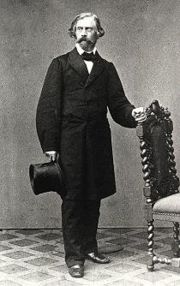
Theodor Hildebrandt
Encyclopedia

Germany
Germany , officially the Federal Republic of Germany , is a federal parliamentary republic in Europe. The country consists of 16 states while the capital and largest city is Berlin. Germany covers an area of 357,021 km2 and has a largely temperate seasonal climate...
painter
Painting
Painting is the practice of applying paint, pigment, color or other medium to a surface . The application of the medium is commonly applied to the base with a brush but other objects can be used. In art, the term painting describes both the act and the result of the action. However, painting is...
, was born at Stettin (Szczecin
Szczecin
Szczecin , is the capital city of the West Pomeranian Voivodeship in Poland. It is the country's seventh-largest city and the largest seaport in Poland on the Baltic Sea. As of June 2009 the population was 406,427....
).
He was a disciple of the painter Schadow
Friedrich Wilhelm Schadow
Friedrich Wilhelm Schadow was a German Romantic painter.-Biography:He was born in Berlin and was the second son of the sculptor Johann Gottfried Schadow....
, and, on Schadow's appointment to the presidency of a new academy in the Rhenish provinces in 1828, followed that master to Düsseldorf
Düsseldorf
Düsseldorf is the capital city of the German state of North Rhine-Westphalia and centre of the Rhine-Ruhr metropolitan region.Düsseldorf is an important international business and financial centre and renowned for its fashion and trade fairs. Located centrally within the European Megalopolis, the...
. Hildebrandt began by painting pictures illustrative of Goethe and Shakespeare; but in this form he followed the traditions of the stage rather than the laws of nature. He produced rapidly "Faust and Mephistopheles" (1824), "Faust and Margaret" (1825), and "Lear and Cordelia" (1828).
He visited the Netherlands with Schadow in 1829, and wandered alone in 1830 to Italy
Italy
Italy , officially the Italian Republic languages]] under the European Charter for Regional or Minority Languages. In each of these, Italy's official name is as follows:;;;;;;;;), is a unitary parliamentary republic in South-Central Europe. To the north it borders France, Switzerland, Austria and...
; but travel did not alter his style, though it led him to cultivate alternately eclecticism
Eclecticism in art
Eclecticism is a kind of mixed style in the fine arts: "the borrowing of a variety of styles from different sources and combining them" . Significantly, Eclecticism hardly ever constituted a specific style in art: it is characterized by the fact that it was not a particular style...
and realism
Realism (arts)
Realism in the visual arts and literature refers to the general attempt to depict subjects "in accordance with secular, empirical rules", as they are considered to exist in third person objective reality, without embellishment or interpretation...
.
At Düsseldorf, about 1830, he produced "Romeo and Juliet," "Tancred and Clorinda," and other works which deserved to be classed with earlier paintings; but during the same period he exhibited (1829) the "Robber" and (1832) the "Captain and his Infant Son," examples of an affected but kindly realism, which captivated the public, and marked to a certain extent an epoch in Prussian art. The picture which made Hildebrandt's fame is the "Murder of the Children of King Edward" (1836), of which the original, afterwards frequently copied, still belongs to the Spiegel collection at Halberstadt.
Comparatively late in life Hildebrandt tried his powers as an historical painter in pictures representing Wolsey and Henry VIII
Henry VIII of England
Henry VIII was King of England from 21 April 1509 until his death. He was Lord, and later King, of Ireland, as well as continuing the nominal claim by the English monarchs to the Kingdom of France...
, but he lapsed again into the romantic in "Othello and Desdemona." After 1847 Hildebrandt gave himself up to portrait-painting, and in that branch succeeded in obtaining a large practice. Hildebrandt was also an entomologist specialising in Coleoptera and a Member of the Entomological Society of Stettin. He died at Düsseldorf in 1874.

